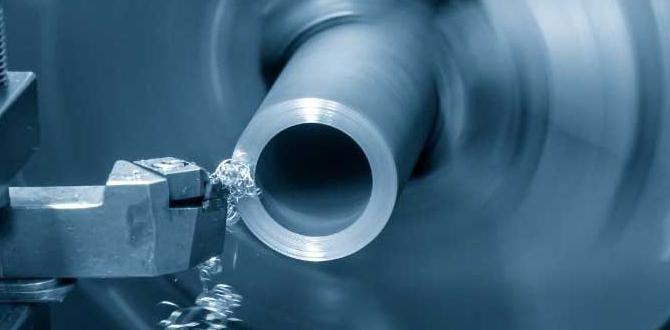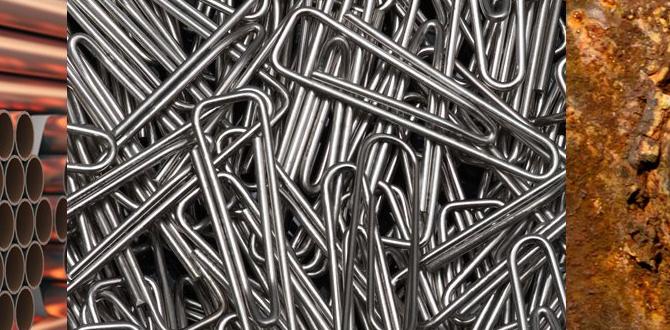To get a mirror finish with a reduced neck end mill, especially on tough materials, focus on slow, controlled spindle speeds, optimal feed rates, and maintaining a rigid setup. Using a high-quality, sharp carbide end mill with a reduced neck is crucial for achieving that flawless, reflective surface without chatter or tool breakage.
Hello, fellow makers and machinists! Ever stared at a part fresh off the mill and seen those frustrating tool marks instead of a slick, shiny surface? You’re not alone. Achieving that sought-after mirror finish on your machined parts can seem like a dark art, especially when you’re just starting out. Many beginners struggle with achieving smooth finishes, often battling chatter, poor surface quality, and even broken tools. But what if I told you a special type of tool, combined with a few precise techniques, could unlock that perfect shine for you? Today, we’re diving deep into the world of the reduced neck end mill and how it can help you achieve a proven mirror finish on your projects. Get ready to elevate your machining game!
Understanding the Reduced Neck End Mill for Superior Finishes
When we talk about achieving a mirror finish, precision is key. A standard end mill works well for many tasks, but for those ultra-smooth, reflective surfaces, a specialized tool often makes all the difference. That’s where the reduced neck end mill shines.
What Exactly is a Reduced Neck End Mill?
A reduced neck end mill, also known as a stepped shank end mill, is designed with a narrower diameter section just above the cutting flutes. This “neck” is significantly smaller than the main cutting diameter.
Here’s why that matters:
Clearance: The reduced neck provides extra clearance. This is vital when machining deep pockets or tight internal corners. A standard end mill might have its shank rub against the workpiece, causing vibration, poor finish, and potential tool damage. The reduced neck avoids this contact.
Reduced Vibration: By minimizing contact in areas where it’s not cutting, the reduced neck design can help dampen vibrations. Less vibration means a smoother cut and, consequently, a better surface finish.
Access to Tight Spots: The slender neck allows the tool to reach areas that a standard end mill with a full-diameter shank simply cannot access without collision.
Why Use One for a Mirror Finish?
Achieving a mirror finish boils down to minimizing surface imperfections. This means preventing chatter, ensuring consistent chip load, and using the right cutting parameters.
A reduced neck end mill contributes to this in several ways:
Reduced Collar Friction: In deep cuts or when machining near vertical walls, the non-cutting portion of a standard end mill shank can rub or collide. The reduced neck eliminates this, preventing unwanted friction that can lead to rough surfaces and tool wear.
Improved Tool Path Control: With less chance of shank interference, the tool can follow the programmed path more accurately, leading to more consistent surface textures.
Ideal for Finishing Passes: These mills are often used as a final finishing tool. Because they can operate with greater clearance and less interference, they are perfect for those delicate final passes that refine the surface to a mirror-like sheen.
A common and highly effective type of end mill for this purpose is a carbide end mill with a 1/8 inch (3mm) or 6mm shank, often designed for materials like PEEK and other high-performance plastics or soft metals, specifically engineered for achieving a mirror finish. The high hardness of carbide coupled with the design benefits of the reduced neck makes it an excellent choice for this specialized task.
Key Factors for Achieving a Mirror Finish
Getting that glassy surface doesn’t happen by accident. It’s a combination of the right tool, the right machine setup, and the right cutting parameters.
1. The Right Tool Selection
Material: For mirror finishes, especially on tougher materials, solid carbide is usually the go-to. Carbide is harder and more heat-resistant than high-speed steel (HSS), allowing for faster cutting speeds and better tool life. High-quality carbide also holds a sharper edge, which is crucial for a clean cut.
Flute Count: For finishing passes aiming for a mirror finish, tools with fewer flutes (2 or 4 flutes) are often preferred. More flutes can pack chips more easily in fine finishing operations, and some designs are better suited for roughing. Two-flute end mills often provide excellent chip evacuation and are very effective for finishing.
Coatings: While not always necessary for plastics, specialized coatings like TiCN (Titanium Carbon Nitride) or AlTiN (Aluminum Titanium Nitride) can improve performance and tool life on certain materials by reducing friction and increasing hardness. However, for many softer materials where mirror finishes are sought, an uncoated or polished carbide tool is often best to avoid material buildup.
Helix Angle: A higher helix angle (e.g., 45 degrees or more) can lead to a smoother shearing action, reducing cutting forces and improving surface finish.
A prime example of a tool for this task is a “carbide end mill 1/8 inch 6mm shank reduced neck for PEEK mirror finish.” The specific diameter (1/8 inch or 6mm shank) often indicates smaller diameter mills, which can be particularly effective for fine detail and achieving smooth surfaces in tight areas. The mention of “PEEK” highlights its suitability for advanced polymers known for their toughness and tendency to get gummy if not machined correctly.
2. Machine Rigidity and Setup
A wobbly setup is the enemy of a good finish. Everything needs to be solid.
Spindle: A clean, well-maintained spindle with minimal runout is essential. Runout (the amount the tool shank deviates from rotating perfectly around the spindle axis) will always result in an inconsistent cut depth and a poor finish.
Tool Holder: Use a high-quality collet or tool holder. A precise collet chuck or shrink-fit holder will minimize runout and ensure the end mill is held securely. Avoid worn-out collets or holders.
Workholding: The workpiece itself must be clamped extremely securely. Any movement or vibration in the workpiece will translate directly to the surface finish. Use vises, clamps, or fixtures that provide maximum stability. For delicate parts, consider using softer jaw inserts to prevent marring.
Machine Condition: Ensure your milling machine is in good working order. A rigid machine with well-adjusted ways and no excessive play in the axes will provide the stable platform needed for fine finishing.
3. Cutting Parameters: The Sweet Spot
This is where the magic really happens. Getting the speed and feed right is critical.
Spindle Speed (RPM)
Too Fast: Can cause excessive heat, leading to tool wear, material melting (especially with plastics), and a gummy finish.
Too Slow: Can lead to rubbing instead of cutting, resulting in a poor surface finish and increased tool pressure.
The Goal: For a mirror finish, you often need to balance a surface speed that allows the carbide to cut effectively with a result that doesn’t generate excessive heat or vibration. For plastics like PEEK, speeds might be lower than for metals, but for certain metals, higher speeds can achieve a mirror finish if chip load is managed.
Typical Approach: Start with recommended speeds for the material and tool manufacturer. For example, for a PEEK finish with a fine-fluted carbide end mill, you might look at RPMs ranging from 5,000 to 15,000, depending on the diameter and specific tool geometry. For metals, speeds can be significantly higher.
Feed Rate (IPM or mm/min)
Too Fast: Can overload the tool, break it, or create a rough, torn surface.
Too Slow: Can cause rubbing, excessive heat, and a poor finish. Chips might not evacuate properly.
Chip Load: This is the thickness of the material being removed by each cutting edge of the end mill. For a mirror finish, you’re typically aiming for a very small chip load. A light, consistent chip is your best friend.
The Goal: A fast, light chip that clears the flutes easily. This is often achieved by increasing the feed rate while keeping the spindle speed appropriate, or by using a multi-pass strategy.
Calculation: Chip Load = (Feed Rate) / (Spindle Speed × Number of Flutes). For finishing, you want a chip load that is just enough to get a clean cut without overstressing the tool. This might be in the range of 0.0005″ to 0.002″ per tooth, depending on the tool diameter and material.
Depth of Cut (DOC) and Stepover
Depth of Cut (Axial): For a mirror finish pass, the axial depth of cut should be very shallow. Often, just a few thousandths of an inch (e.g., 0.005″ to 0.010″) is sufficient to refine the surface without introducing heavy cutting forces.
Stepover (Radial): This is the distance the tool moves sideways between passes. For a mirror finish, a small stepover is crucial to ensure that subsequent passes slightly overlap or blend seamlessly with the previous ones. A stepover of 20-50% of the tool diameter is common. For ultra-fine finishes, even smaller stepovers can be employed.
Step-by-Step Guide: Achieving a Mirror Finish
Let’s break down the process of achieving that sought-after mirror finish using a reduced neck end mill.
Step 1: Material and Tool Selection
Identify Your Material: What are you cutting? Plastics like PEEK, ABS, or Nylon? Soft metals like aluminum or brass? Or harder metals like mild steel? This will dictate your tool choice and parameters.
Select the Correct Reduced Neck End Mill:
For PEEK and similar plastics, a 2-flute, polished carbide end mill with a reduced neck and a 1/8 inch (3mm) or 6mm shank is an excellent starting point. For aluminum, a similar tool but potentially with a higher helix angle and maybe a bright (uncoated) finish would work well.
Ensure the tool diameter is appropriate for the feature you are finishing.
Check Tool Condition: Inspect your end mill for any signs of wear or damage. A sharp, clean tool is paramount.
Step 2: Machine Setup and Workholding
Clean Everything: Ensure your spindle, tool holder, and work area are clean.
Secure Tool Holder: Install your collet or tool holder into the spindle. Use a high-quality, properly sized collet.
Mount the End Mill: Insert the reduced neck end mill into the tool holder. Ensure it is seated properly and tightened securely. Check that the neck of the end mill is not bottoming out in the tool holder if that could cause an issue.
Clamp the Workpiece: Securely clamp your workpiece. Use rigid workholding methods that prevent any movement or vibration. Consider soft jaws if the material is delicate.
Step 3: Initial Parameter Calculation & Testing
Consult Resources: Refer to tool manufacturer datasheets or online calculators for recommended starting speeds and feeds for your specific material and tool diameter. Search for “cutting parameters for [your material]” and “[your end mill diameter] carbide end mill”.
Calculate Chip Load: Use the formula: Chip Load = (Feed Rate) / (Spindle Speed × Number of Flutes). Aim for a light chip load suitable for finishing.
Spindle Speed: Set your spindle to a conservative, appropriate speed for your material and tool. For many plastics, this might be between 5,000-15,000 RPM. For metals, it could be higher.
Surface Finish Pass Parameters:
Axial Depth of Cut (DOC): Set very shallow, e.g., 0.005″ to 0.010″ (0.1mm to 0.25mm).
Radial Stepover: Set to 30-50% of the tool diameter.
Feed Rate: Initially, set this based on your calculated chip load and spindle speed. For example, if you want a chip load of 0.001″ per tooth with a 2-flute end mill at 10,000 RPM, your feed rate would be: 10,000 RPM 2 flutes 0.001″ chip load = 20 IPM (inches per minute).
Step 4: Executing the Finishing Pass
Engage the Spindle: Start the spindle.
Initiate the Cut: Begin your finishing pass using the calculated parameters. Listen to the machine. A smooth, consistent cutting sound is good; chattering or squealing is bad.
Observe Chip Formation: Watch the chips coming off the tool. They should be small, consistent, and clean. For plastics, they might look like fine shavings. For metals, they should be well-formed. If chips are stringy or melting, your speed might be too high, or your feed too low for the material type.
Check the Result: Once the pass is complete, carefully inspect the surface. Is it starting to look reflective? If not, you may need to adjust parameters.
Step 5: Fine-Tuning for the Perfect Finish
This is an iterative process. Don’t be afraid to make small adjustments.
If the finish is still rough:
Slightly increase feed rate: This can help create a more aggressive cut, reducing rubbing and improving chip formation.
Slightly decrease spindle speed: This can reduce heat if melting is an issue.
Reduce the axial depth of cut: Even shallower passes can sometimes clean up a surface better.
Ensure rigidity: Double-check all clamping and machine setup.
If the tool is struggling or chattering:
Decrease feed rate: This reduces the load on the tool.
Increase spindle speed: This can help the tool cut more efficiently and avoid rubbing.
Check tool seating: Ensure the end mill is perfectly centered in the collet.
Address vibration: Look for any sources of vibration in the machine or workpiece.
Important Note on Coolant/Lubrication: For plastics, a flood coolant is usually avoided as it can cause swelling. Air blast or a mist coolant works best. For metals, flood coolant or a good cutting fluid is essential for chip evacuation, cooling, and surface finish.
Specific Tool Example: Carbide End Mill 1/8 Inch 6mm Shank Reduced Neck for PEEK Mirror Finish
Let’s zoom in on a very specific, yet common, scenario: achieving a mirror finish on PEEK using a reduced neck end mill. PEEK (Polyetheretherketone) is a high-performance polymer that can be challenging to machine due to its toughness and tendency to melt.
Why This Specific Tool is Ideal for PEEK
Carbide: Its hardness and heat resistance are essential for cutting tough polymers.
1/8 inch (3mm) or 6mm Shank: These smaller shank diameters mean the tool itself is likely a smaller diameter end mill, ideal for fine finishing and detailed work. The reduced neck on these smaller tools also provides excellent clearance in tight geometries.
Reduced Neck: Crucial for avoiding rub marks and enabling access into pockets without the shank interfering with the walls.
* Designed for Mirror Finish: Many such tools will have polished flutes and optimized geometries (like a lower helix angle or specific edge preparation) to promote smooth shearing and prevent plastic buildup.
Recommended Parameters for PEEK (General Guidance – Always Test!)
These are starting points. Actual parameters will depend on your specific machine, tool, and coolant setup.
| Parameter | Value Range (Typical) | Notes |
| :——————– | :———————————————————- | :———————————————————————————————————————————————— |
| Spindle Speed (RPM) | 8,000 – 18,000 | Higher speeds reduce cycle time but increase heat. Use air blast or mist coolant to manage heat. Keep it consistent. |
| Feed Rate (IPM/mm/min) | 15 – 40 IPM (380 – 1000 mm/min) | This needs to be balanced with RPM to achieve chip load. |
| Chip Load per Tooth | 0.0005″ – 0.001″ (0.013mm – 0.025mm) | Very light chip load is critical for plastics to prevent melting and tear-out. |
| Axial Depth of Cut | 0.005″ – 0.010″ (0.1mm – 0.25mm) | Shallow pass to refine the surface. |
| Radial Stepover | 30% – 60% of tool diameter | Sufficient overlap to blend surface textures. For PEEK, smooth steps are key. |
| Coolant/Lubrication | Air blast or Mist Coolant | Avoid flood coolant for most plastics as it can cause material swelling. Keep the cutting zone cool and clear of chips. |
| Tool Material | Solid Carbide (polished or bright finish) | Hardness and heat resistance are vital. |
| Flute Count | 2 | Excellent for chip evacuation in plastics. |
External Resource Inspiration: For detailed cutting data and best practices on machining polymers like PEEK, resources from manufacturers such as Ensinger or Boedeker Plastics can provide invaluable insights. These sites often offer downloadable machining guides and technical specifications.






